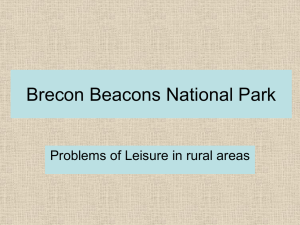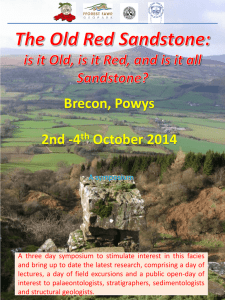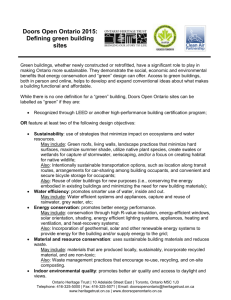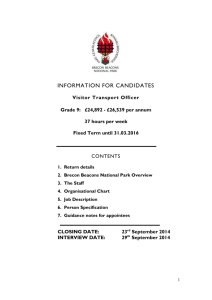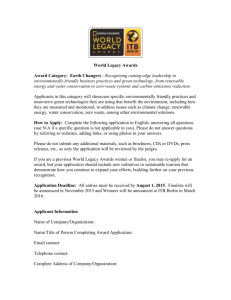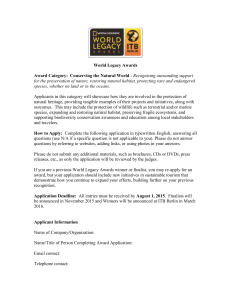BIP1 2015_2016 English - Brecon Beacons National Park Authority
advertisement
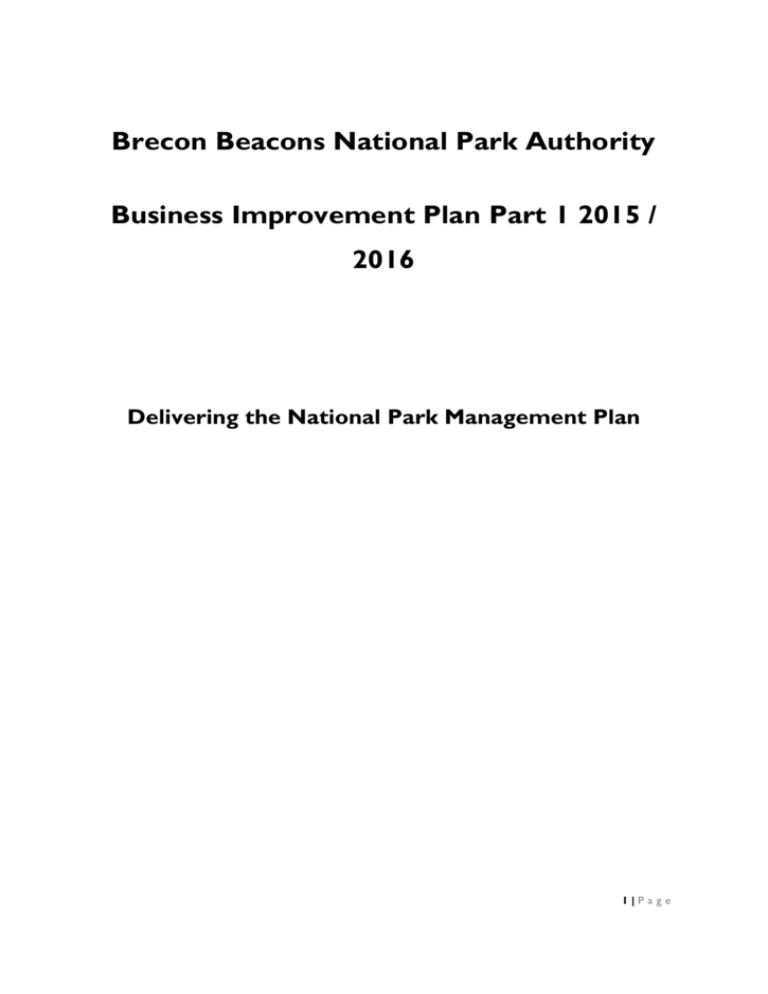
Brecon Beacons National Park Authority Business Improvement Plan Part 1 2015 / 2016 Delivering the National Park Management Plan 1|Page Our Vision for the Brecon Beacons National Park The following vision statements describe the overarching ambitions for the Park for the next 20 years. These statements are the result of an extensive consultation process which investigated the Park’s current state and its desired future condition. The vision and aims are based on the collective views of the participants as well as policy directives and ambitions from governing bodies. They answer the question, “What should the Brecon Beacons National Park be like in 2030?” Managing Change Together - In 2030 the Brecon Beacons National Park will be: Recognised internationally and nationally for its value as a protected area, whose character continues to be shaped by the long-standing interactions between people and the processes of nature Widely acclaimed for its natural beauty, geodiversity, biodiversity and cultural heritage which are being conserved and enhanced by its stakeholders through traditional and innovative means A sought-after destination providing an outstanding variety of sustainable opportunities for all to understand and enjoy its tranquillity, rural character, Welsh way of life, sense of remoteness and other special qualities Resilient, open and responsive to change – particularly climate change - and its stakeholders proactive in mitigating and adapting to the effects of undesirable change through local action Less dependent upon external supply chains leading to increased food and energy security locally, improved quality of life, community cohesion and conservation of natural capital A living landscape where people can earn a living from the land in an innovative and sustainable manner, for example through farming, but also in new ways such as through renewable energy production, for the benefit of the environment, economy and local communities Managed sustainably through active partnerships among the Park’s stakeholders so that it continues to be a source of inspiration and enjoyment for future generations Monitored over the long term to improve future policy and management practice 2|Page Contents Brecon Beacons National Park Authority .............................................................................................. 1 Business Improvement Plan Part 1 2015 / 2016 ..................................................................................... 1 Delivering the National Park Management Plan ..................................................................................... 1 Our Vision for the Brecon Beacons National Park ............................................................................ 2 Managing Change Together - In 2030 the Brecon Beacons National Park will be: .... 2 1. Introduction ............................................................................................................................. 5 2. Linking the Improvement Plan to the Management Plan ............................................ 5 3. What are our Improvement Priorities for 2015/2016 ................................................... 6 4. Aligning Improvement Priorities with Available Resources ........................................ 8 5. Working with Partners ......................................................................................................... 8 6. Scrutiny ..................................................................................................................................... 8 7. Delivering our 2015/2016 Improvement Priorities......................................................... 9 Improvement Priority 1: Through effective partnership, facilitation, practical action and the planning function the Park’s historic environment and cultural heritage will be conserved, enhanced and promoted. .. 10 Why are we focusing on this Improvement Priority?....................................................................... 10 What we will do ............................................................................................................................... 11 How will we do it? ............................................................................................................................ 11 How will we know if we are achieving the protection and enhancement of the Park’s archaeology and its most vulnerable listed buildings? ........................................................................................... 11 Improvement Priority 2: Through effective partnership, facilitation, practical action and the planning function the National Park’s landscapes and biodiversity will benefit from broad-scale targeted and promoted conservation projects ............................................................................................................................... 12 Why are we focusing on this Improvement Priority?....................................................................... 12 What we will do ............................................................................................................................... 12 How will we do it? ............................................................................................................................ 13 How will we know if we are achieving bringing an area of habitat and landscape into active conservation management? ............................................................................................................... 13 Improvement Priority 3: Visitors from a wide range of backgrounds will have access to a sustainably managed range of recreation opportunities............................................................................................... 14 Why are we focusing on this Improvement Priority?....................................................................... 14 What we will do ............................................................................................................................... 14 How will we do it? ............................................................................................................................ 14 How will we know if visitors from a wide range of backgrounds have had the opportunity to access and enjoy the National Park and that we have ensured that people of all abilities and backgrounds can access areas within the National Park? ................................................................. 14 3|Page Improvement Priority 4: The vitality & viability of communities and their businesses will be supported with the aim of developing a sense of shared responsibility. Work with the tourism sector will be particularly prioritised whilst understanding and awareness amongst visitors and residents will be promoted ................. 16 Why are we focusing on this Improvement Priority?....................................................................... 16 What we will do ............................................................................................................................... 16 How will we do it? ............................................................................................................................ 17 How will we know if we have achieved awareness and understanding, social resilience and sustainable economic development? ................................................................................................. 17 8. Monitoring Performance ............................................................................................................... 19 Appendix 1 – Business Improvement Plan Priorities 2015/2016 ......................................................... 21 4|Page 1. Introduction National Parks are Category V protected landscapes as defined by the International Union for Conservation of Nature (IUCN) where the interaction of people and nature over time has produced an area of distinct character with significant ecological, biological, cultural and scenic value. They designated under the Environment Act, 1995. Section 61 of this Act sets out the Park’s two main purposes: 1. ‘to conserve and enhance the natural beauty, wildlife and cultural heritage of the National Parks’ 2. ‘to promote opportunities for the understanding and enjoyment of the special qualities by the public’ Category V protected areas are also living and working landscapes. As such the Brecon Beacons National Park Authority, in pursuit of the two statutory purposes, has a duty to: ‘seek to foster the economic and social wellbeing of local communities within the National Park by working closely with the agencies and local authorities responsible for these matters’ At the start of each financial year, the National Park Authority is required by the Local Government (Wales) Measure 2009 to publish a forward facing Improvement Plan setting out our improvement priorities and objectives for the financial year ahead. We are also required to publish our own assessment of how well we have performed against these improvement priorities and objectives by the 31 October. The Brecon Beacons National Park Authority is committed to securing continuous improvement in the delivery of its efficient and resourceful services. Our work has a direct impact on the people who access the services of the National Park Authority and we want to be open and transparent about our priorities and how we are performing. 2. Linking the Improvement Plan to the Management Plan National Park Management Plan 201030 Corporate Goals Improvement Priorities Team and individual actions Our strategic drivers for 20 years Derived from the Plan, achieved over a 35 year period Derived from the corporate goals achieved over a 1-3 year period How we will achieve the annual priorities 5|Page Performance indicators How we will measure what we have done and assess whether we have achieved the objectives and what impact they have had. Table 1: Performance Management and Reporting The Brecon Beacons National Park Management Plan is the single most important policy document for the National Park. It sets the vision and provides the framework for decision making and priority development. The Plan was prepared with the active participation of stakeholders and the wider community and its objectives are categorised into 6 themes within which specific actions fall. The six themes are used to agree and report on outcomes and improvement priorities in the Improvement Plan. The annual review of goals and priorities is therefore an important part of the Management Plan review process. The Plan was adopted in 2010 and covers a 5 year period until 2015. The Management Plan is currently being reviewed with a view to rolling forward existing actions for the period 2015-2020. The Authority’s Corporate Goals are the same as the six Management Plan themes and can be seen in Table 2 below. Management Plan Themes/Corporate Goals Theme 1: Managing Park Landscapes to Maximise Conservation and Public Benefits Theme 2: Conserving and Enhancing Biodiversity Theme 3: Provide Opportunities for Outdoor Access and Recreation Theme 4: Raising Awareness and Understanding of the Park Theme 5: Building and Maintaining Sustainable Communities, Towns and Villages Theme 6: Sustainable Economic Development Table 2: Management Plan Themes/Corporate Goals 3. What are our Improvement Priorities for 2015/2016 The Authority has been using nine improvement priorities within the six Corporate Goals since 2012/2013. Due to the interrelated nature of many of the improvement priorities and the desire to make performance reporting more cohesive in its nature, the Authority decided in February 2015 to consolidate the nine improvement priorities to 4 from 2015/2016. This will also mean that we are more able to focus our resources on all of our Corporate Goals. For the forthcoming financial year the improvement priorities are as follows, with an accompanying rationale ‘Why are we focusing on this Improvement Priority?’ in chapter 7 ‘Delivering our 2015/2016 Improvement Priorities’: 6|Page Improvement Priority 1 Through effective partnership, facilitation, practical action and the planning function the Park’s historic environment and cultural heritage will be conserved, enhanced and promoted Improvement Priority 2 Through effective partnership, facilitation, practical action and the planning function the National Park’s landscapes and biodiversity will benefit from broad-scale targeted and promoted conservation projects Improvement Priority 3 Through effective partnership, facilitation, practical action and the planning function, Visitors from a wide range of backgrounds will have access to a sustainably managed range of recreation opportunities Improvement Priority 4 Through effective partnership, facilitation, practical action and the planning function, the vitality & viability of communities and their businesses will be supported with the aim of developing a sense of shared responsibility. Work with the tourism sector will be particularly prioritised whilst understanding and awareness amongst visitors and residents will be promoted A full table showing the priorities, objectives, measures and targets for 2015/2016 is shown in Appendix 1. The interrelated nature of the Park’s First and Second Purpose and the Authority’s 6 Corporate Goals is demonstrated in the diagram below: Interrelated Nature of the Park’s Purposes and Duty 7|Page The format for performance reporting remains as follows: Corporate Goals (Management Plan Themes) Improvement Priorities Improvement Objectives Measure Target 4. Aligning Improvement Priorities with Available Resources 2015/2016 will be another very challenging budget year for us. The financial environment and outlook facing us is increasingly more difficult and there is no hiding from the scale of the challenges we are experiencing. Increasing demand, reduction of resources and alternative delivery mechanisms mean we cannot provide financial protection or additional resources on the scale we have done previously. The decision to roll forward the Corporate Goals from the previous financial year reflects the Authority’s intention to deliver on its Corporate Goals, while also allowing time to concentrate on making real progress within identified areas. By consolidating the Improvement Priorities the Authority will be able to monitor progress against an objective in each of the six Corporate Goals. 5. Working with Partners The Management Plan is prepared with the active participation of key stakeholders and the wider community to foster shared ownership of and support for the vision, aims, objectives, policies and actions. This is increasingly important because shared resources and knowledge can overcome some of the barriers presented by the current financial climate. Partnership working also helps present a united front and generates support from the public. 6. Scrutiny As well as external audits, the National Park Authority conducts its own auditing process through a series of scrutiny reviews which are linked to improvement priorities. Two reviews are carried out 8|Page each year, the first focuses on an improvement priority from the previous financial year (2014-15) and the second looks at progress on one of the improvement priority we have chosen for the current financial year 2015-16. We are keen to involve the people who benefit from our services in these reviews and the public are able to vote on which improvement priority ought to be the focus of the first scrutiny review. The Authority takes the final decision, but the public vote is a key part of their deliberations. When a subject has been selected members of the public are invited to take an active role in the scrutiny process and feed their views into the panel. 7. Delivering our 2015/2016 Improvement Priorities The Authority delivers services via its three Directorates: Chief Executive Countryside and Land Management Planning Corporate support and services including Management Plan preparation, democratic services, human resources, communications, IT, finance, legal and administration services. Conservation, land management, rights of way, sustainable tourism, sustainable communities, community development, warden and estate services, biodiversity and ecology, Fforest Fawr Geopark, property management, Visitor and Tourist Information Centres. Planning services, development control, enforcement, strategy and policy, built heritage. Continuous improvements and attention to the needs of those who use our services are important to us and we realise that in the light of financial cutbacks and savings in the public sector, these will be challenging. 9|Page Improvement Priority 1: Through effective partnership, facilitation, practical action and the planning function the Park’s historic environment and cultural heritage will be conserved, enhanced and promoted. Why are we focusing on this Improvement Priority? The historic environment and cultural heritage forms a link between the 2 Purposes and Duty of the National Park Authority and contributes to all aspects of sustainable development. ‘The Welsh historic environment is a valuable asset that plays a key role in enhancing the economic, social and environmental wellbeing of communities in Wales. The active care and promotion of this asset is essential; once elements have been lost or forgotten they can rarely be recovered1.’ Archaeology in the Brecon Beacons National Park is a key part of its historic environment. A Scheduled Ancient Monument (SAM) is an archaeological site that is of national importance. They have been granted special legal protection by Cadw and the Welsh Government. Archaeology does not have to be a particular age to be Scheduled, and sites have been scheduled that come from the prehistoric period right through to examples from the Second World War. SAMs come in all different shapes and sizes from individual Bronze Age burial cairns to very large industrial complexes. Only the best examples of each type of monument is Scheduled, and sites are chosen based on criteria such as condition, rarity, extent of survival, vulnerability and group value. Within the Brecon Beacons National Park there are 357 SAMs. The National Park Authority is committed to conserving and enhancing these SAMs. Built heritage is central to the National Park’s cultural heritage. It is something that both resident and visitor relate to and enhancing it creates a unique sense of place. The Authority is committed to protecting and improving the National Park’s built heritage by decreasing the number of listed buildings at risk. Currently, the Brecon Beacons National Park is home to 1,955 listed buildings, some of which are particularly vulnerable and need repair and maintenance. These vulnerable listed buildings make up the ‘Buildings at Risk’ register. As these buildings are privately owned the Authority needs to work hard with owners to raise awareness of their status by offering assistance and advice to help them maintain and look after their buildings. There are also grants available that the Authority can use to assist owners protect their buildings for generations to come. 1 ‘Valuing the Welsh Historic Environment’ – The National Trust 2010 10 | P a g e What we will do Within this Improvement Priority we have identified two improvement objectives that cover Scheduled Ancient Monuments and Listed Buildings. Improvement Objective 1: We will protect and enhance the Park's archaeology Improvement Objective 2: We will conserve and enhance the Park's most vulnerable listed buildings How will we do it? We will undertake positive conservation measures on Scheduled Ancient Monuments We will reduce the amount of buildings on the ‘Buildings at Risk’ register (a register of Listed Buildings considered to be ‘at risk’ which the authority is required to prepare). How will we know if we are achieving the protection and enhancement of the Park’s archaeology and its most vulnerable listed buildings? We will have undertaken positive conservation measures on at least 2 Scheduled Ancient Monuments and we will have removed 3 buildings from the ‘Buildings at Risk’ register. Corporate Goal Managing the National Park’s landscapes to maximise conservation and public benefits Improvement Priority The Park’s historic environment & cultural heritage will be conserved, enhanced and promoted Improvement Objective Protect and enhance the Park's archaeology Conserve and enhance the Park's most vulnerable listed buildings Measure Undertake positive conservation measures on Scheduled Ancient Monuments Reduce the amount of buildings on the Buildings at Risk register Target 2014/2015 Actual 2014/2015 Target 2015/2016 2 Scheduled Ancient Monuments n/a 2 Scheduled Ancient Monuments Team Heritage 6 buildings removed from the Buildings at Risk register awaiting data – expected end of March 2015 3 buildings removed from the Buildings at Risk register 11 | P a g e Improvement Priority 2: Through effective partnership, facilitation, practical action and the planning function the National Park’s landscapes and biodiversity will benefit from broad-scale targeted and promoted conservation projects Why are we focusing on this Improvement Priority? Conserving and enhancing the natural beauty and wildlife of the National Park is enshrined in the 1st Purpose of National Park Authorities and it is also inherent to the 2nd Purpose and Duty. It is central to achieving the vision of the Brecon Beacons National Park Authority. Biodiversity is all around us in the air, earth and water. Living things are always changing and finding new ways to live and new species evolve to make use of available resources and so build up complex relationships with the other species around them. These relationships build ecosystems where each animal or plant relies on the others to provide the necessary requirements for life: food, space to live and the means to reproduce the next generation. The diversity of conditions in the natural environment provides numerous opportunities for different species to find the place they are most suited to live - their habitats. The diversity of species helps to ensure that ecosystems are healthy and that species can continue to evolve as conditions change. The genetic diversity between individuals of each species helps to make each generation strong enough to be able to evolve and adapt. The Brecon Beacons National Park comprises 520 square miles or 1346km2, about 6.7% of Wales by area. The uplands comprise about 60% of the Brecon Beacons National Park or about 4% of Wales by area. They include some of the largest areas of contiguous, uninterrupted common land in Wales, including 3 of Wales’ 4 adjoining commons of over 4000 hectares each. Ensuring their conservation and enhancement is at the heart of National Park Purposes. Glastir is an opportunity to improve large areas of the uplands and productive farmland in sensitive areas, this also includes the opportunity to build relationships ‘on the ground’. What we will do We have identified two improvement objectives and set relevant measures and identified achievable targets which relate clearly to the Improvement Priority. The improvement objectives are: Improvement Objective 3: Through partnership working and facilitation, we will bring an area of habitat into active conservation management. 12 | P a g e Improvement Objective 4: Through partnership working and facilitation, we will bring an area of landscape into active conservation management. How will we do it? We will improve a Special Area of Conservation, Llangasty Caeau Ty Mawr, through positive management intervention methods. We will facilitate the delivery phase of Glastir at Mynydd Du. How will we know if we are achieving bringing an area of habitat and landscape into active conservation management? We will have confirmed the grazing management for Llangasty Caeau Ty Mawr. This is necessary to achieve our ultimate aim of achieving 'Favourable Conservation Status' for Llangasty Caeau Ty Mawr (European Union's Habitats Directive). We will have carried out controlled heather burning on at least one Glastir Common within Mynydd Du. Corporate Goal Managing the National Park’s landscapes to maximise conservation and public benefits; Conserving and enhancing biodiversity 2 Improvement Priority Improvement Objective The National Park’s biodiversity will benefit from broad-scale targeted and promoted conservation projects Biodiversity Through partnership working and facilitation, bring an area of habitat into active conservation management The National Park’s landscapes will benefit from broad-scale targeted and promoted conservation projects Managing the Landscape Through partnership working and facilitation, bring an area of landscape into active conservation management Measure Llangasty Caeau Ty Mawr SAC will benefit from positive management intervention methods Facilitate the delivery phase of Glastir at Mynydd Du Target 2014/2015 A working draft of the LlangastyCaeau Ty Mawr Management Plan is approved by the Steering Group by the end of the fiscal year2 Facilitate the implementati on of one Glastir Capital Works Agreement in partnership with one Mynydd Du grazing association Subsequent BIP reports will demonstrate progress against actions within this plan Actual 2014/2015 Target 2015/2016 Team Approved Approved Confirm the grazing management for the site. Conservation Carry out controlled heather burning on at least one Glastir common Conservation 13 | P a g e Improvement Priority 3: Visitors from a wide range of backgrounds will have access to a sustainably managed range of recreation opportunities Why are we focusing on this Improvement Priority? Outdoor access and recreation are inherent parts of the Park’s second purpose - to promote opportunities for the enjoyment and understanding of its special qualities. The Brecon Beacons National Park offers opportunities for a wide range of air, water and land-based recreational activities and for the promotion of healthy lifestyles. The challenge for all involved is to enable all sectors of society to enjoy the Park in legitimate and sustainable ways which do not conflict with the Park’s first purpose or detract from its special qualities. What we will do We have identified an improvement objective and set relevant measures and identified achievable targets which relate clearly to the Improvement Priority. The improvement objective is: Improvement Objective 5: We will ensure that visitors from a wide range of backgrounds have the opportunity to access and enjoy the National Park receiving Health and Well-being benefits. Improvement Objective 6: We will sustainably manage the Rights of Way network for residents and visitors of all abilities and backgrounds. How will we do it? We will deliver a geocaching project (Sport Wales Funded) with young people and we will deliver an Inspironment project (NRW funded) with excluded groups. We will deliver the Rights of Way Improvement Plan (ROWIP). How will we know if visitors from a wide range of backgrounds have had the opportunity to access and enjoy the National Park and that we have ensured that people of all abilities and backgrounds can access areas within the National Park? 300 young people and 30 coaches will have benefitted from the geocaching project. 10 sample itineraries will have been prepared and there will have been 4 group training sessions. 16 group leaders will have been trained and will be delivering visits. We will have completed at least 4 projects under the Rights of Way Improvement Plan. . 14 | P a g e Corporate Goal Provide Opportunities for Outdoor Access and Recreation giving Health and Wellbeing benefits Improvement Priority Visitors from a wide range of backgrounds will have access to a sustainably managed range of recreation opportunities Improvement Objective We will ensure that visitors from a wide range of backgrounds have the opportunity to access and enjoy the National Park receiving Health and Well-being benefits. We will sustainably manage the Rights of Way network for residents and visitors of all abilities and backgrounds. Measure Deliver geocaching project (Sport Wales funded)with young people Deliver Inspironment project (NRW funded) with excluded groups Deliver the Rights of Way Improvement Plan (ROWIP). Target Actual 2014/2015 2014/2015 N/A N/A N/A N/A N/A N/A Target 2015/2016 Team 300 young people benefit and 30 coaches 10 sample itineraries, 4 group training sessions and 16 group leaders trained and delivering visits Complete at least four ROWIP projects 15 | P a g e Sustainable Communities Public Rights of Way Improvement Priority 4: The vitality & viability of communities and their businesses will be supported with the aim of developing a sense of shared responsibility. Work with the tourism sector will be particularly prioritised whilst understanding and awareness amongst visitors and residents will be promoted Why are we focusing on this Improvement Priority? We have a statutory duty to foster the economic and social well-being of communities living within the National Park. By focusing on this improvement priority we can support communities in the park to develop conventional and innovative approaches to maintaining the National Park as a place to live and work in a sustainable manner. In turn, this will develop social resilience and community pride. An example of how we support community resilience is through the Sustainable Development Fund. The Authority is required through its Second Purpose to raise awareness and understanding of the Park. Example of how this is done are the Ambassador School Programme and by providing information about the National Park in healthcare settings within the National Park. There is a tension between the economic advantages derived from encouraging tourists to visit the area and the negative impact in terms of increased carbon footprint and pollution from travelling with limited public transport infrastructure. The National Park Authority has introduced and is taking forward a number of creative and innovative solutions, such as National Park Ambassadors, Business Training and Green Tourism schemes. What we will do We have identified 3 improvement objectives within which we have set relevant measures and identified achievable targets which relate clearly to the Improvement Priority. The improvement objectives are: Improvement Objective 7: We will develop an Ambassador Schools programme and ensure that information about the National Park is available in healthcare settings Improvement Objective 8: We will support community resilience projects with SDF and development officer advice & assistance Improvement Objective 9: We will maintain activity in Ambassadors, Business Training and Green Tourism after the end of Rural Alliances funding 16 | P a g e How will we do it? We will ensure that schools within and around the park will participate and benefit from participating in the National Park Ambassador Schools project. We will provide opportunities to use the National Park for health and well-being benefit in and information in healthcare settings within the National Park. We will support National Park related community resilience projects through the Sustainable Development Fund and development officer advice and assistance. We will measure the number of businesses engaged within the Ambassadors, Business Training and Green Tourism schemes after the end of Rural Alliances funding. How will we know if we have achieved awareness and understanding, social resilience and sustainable economic development? 4 schools will achieve the Ambassador Schools award and 10 will register. 5 healthcare settings will agree to promote the National Park. 50 National Park related community resilience projects will have been supported by the Brecon Beacons National Park Authority. There will be 120 Ambassadors, 10 training courses and 40 green tourism businesses. 17 | P a g e Corporate Goal Raising Awareness and Understanding; Improvement Priority The vitality & viability of communities and their businesses will be supported with the aim of developing a sense of shared responsibility. Work with the tourism sector Building and will be Maintaining particularly Sustainable prioritised Communities, whilst Towns and understanding Villages; and awareness amongst visitors and residents will be promoted Sustainable Economic Development Improvement Objective We will develop an Ambassador Schools programme and ensure that information about the National Park is available in healthcare settings Support community resilience projects with SDF and development officer advice & assistance Measure Target Actual 2014/2015 2014/2015 Schools within and around the park will participate and benefit from participating in the National Park N/A Ambassador Schools project. Information and opportunities to use the National Park for Health and Wellbeing benefit will be provided in N/A healthcare settings within the National Park. Number of National Park related community resilience projects supported by N/A Brecon Beacons National Park Authority Maintain activity in Ambassadors, Number of businesses Business Training and engaged within these N/A Green Tourism after elements the end of Rural Alliances funding N/A Target 2015/2016 Team 4 schools will achieve the award. 10 will register. Education; N/A N/A 5 healthcare settings will agree to promote the National Park 50 Sustainable Communities; Ambassadors: 120 N/A Training courses: 10 Green tourism businesses: 40 Sustainable Tourism 18 | P a g e 8. Monitoring Performance These details will be measured, recorded and assessed in our Performance Management System called ‘Ffynnon’ and will provide the basis for reporting our performance. The information uploaded into Ffynnon comprises of core data on statutory performance indicators and local performance indicators which shows each Directorate’s work in context by showing workload, cases, figures, numbers and targets. Ffynnon reports are generated quarterly and presented to the National Park Authority Committee highlighting the areas that have improved or areas that require attention. In order to monitor effectiveness and efficiency, progress reports will also be delivered to the Audit and Scrutiny Committee every quarter on one selected improvement priority. In addition to this, the Authority will continue to benchmark its performance with the other National Parks of Wales and these details will also be presented to the National Park Authority Committee when available. The improvements will be evidenced in a variety of ways including: Performance indicators (which include those that are national and statutory ones and those that are local) Consultation with stakeholders and service users through surveys and other means. Internal assessment Inspection by the Welsh Audit Office Benchmarking and meeting targets We have strong corporate governance and internal measures to manage the conduct of the Authority. We have adopted a model code supported by guidance from the Public Service Ombudsman for Wales3. The code is based on seven principles of public life, first set out in the Committee on Standards in Public Life (the Nolan Committee) and most recently defined in Wales in a Statutory Instrument as: 1. Selflessness 2. Honesty 3. Integrity and Propriety 4. Duty to Uphold the Law 5. Stewardship 6. Objectivity in Decision-making 7. Equality and Respect 8. Openness 9. Accountability 3 http://www.ombudsman-wales.org.uk/en/publications/?pID=254 19 | P a g e 10. Leadership A range of policies have been adopted within the Authority to achieve these principles. They are supported by the Members, Officers, the Audit and Scrutiny Committee, the Standards Committee, the Monitoring Officer, the Solicitors of the Authority, the Complaints Procedure and the Freedom of Information Act. We will ensure that we apply these principals to our decision making and our commitment to improve our services. This Improvement Plan sits within an ambitious planning framework, the National Park Management Plan, which maps developments in the Park up to 2030. Our experiences will continue to inform and influence work programmes, budgets and funding proposals as we strive to exceed our targets. If you would like any additional information on the Improvement Plan or would like to suggest areas of work where we require improvement please write to Mr John Cook, Chief Executive, Brecon Beacons National Park Authority, Plas y Ffynnon, Cambrian Way, Brecon LD3 7HP, Powys or email improvements@breconbeacons.org Published: April 2015 Statement of Responsibility Brecon Beacons National Park Authority is responsible for preparing this Improvement Plan, the information and the assessments laid out within it and the estimates on which they are based. The Authority is also responsible for managing its performance improvements and the internal control measures from which the information and assessment in this Plan have been produced. The Authority is satisfied that the contents of the Plan are in all material respects accurate and complete, realistic and achievable within the resources available. 20 | P a g e Appendix 1 – Business Improvement Plan Priorities 2015/2016 Corporate Goals Theme 1: Managing Park Landscapes to Maximise Conservation and Public Benefits Theme 2: Conserving and Enhancing Biodiversity Theme 3: Provide Opportunities for Outdoor Access and Recreation giving Health and Well-being benefits Improvement Priorities The Park’s historic environment & cultural heritage will be conserved, enhanced and promoted The National Park’s landscapes and biodiversity will benefit from broadscale targeted and promoted conservation projects Visitors from a wide range of backgrounds will have access to a sustainably managed range of recreation opportunities Theme 6: Sustainable Economic Development Target 2015/2016 Undertake positive conservations measures on Scheduled Ancient Monuments Conserve and enhance the Park's most vulnerable listed buildings Reduce the amount of buildings on the buildings at risk register. Listed Buildings: 3 buildings removed from the Buildings at Risk Register Bring area of habitat into active conservation management Llangasty Cae Ty Mawr SAC will benefit from positive management intervention methods Confirm the grazing management for the site. Bring an area of landscape into active conservation management Facilitate the delivery phase of Glastir at Mynydd Du Carry out controlled heather burning on at least one Glastir common Deliver Geocaching project (Sport Wales Funded) with young people 300 young people benefit and 30 coaches Deliver Inspironment project (NRW funded) with excluded groups 10 sample itineraries, 4 group training sessions and 16 group leaders trained and delivering visits Deliver the Rights of Way Improvement Plan (ROWIP) Complete at least four ROWIP projects Schools within and around the park will participate and benefit from participating in the National Park Ambassador Schools project. 4 schools will achieve the award. 10 will register. Information and opportunities to use the National Park for Health and Well-being benefit will be provided in healthcare settings within the National Park. 5 healthcare settings will agree to promote the National Park Support community resilience projects with SDF and development officer advice & assistance Number of National Park related community resilience projects supported by Brecon Beacons National Park Authority 50 Maintain activity in Ambassadors, Business Training and Green Tourism after the end of Rural Alliances funding Number of businesses engaged within these elements Number of Ambassadors: 120; number of training courses: 10; number of green tourism businesses: 40 We will ensure that visitors from a wide range of backgrounds have the opportunity to access and enjoy the National Park receiving Health and Wellbeing benefits We will develop an Ambassador Schools programme and ensure that information about the National Park is available in healthcare settings The vitality & viability of communities and their businesses will be supported with the aim of developing a sense of shared responsibility. Work with the tourism sector will be particularly prioritised whilst understanding and awareness amongst visitors and residents will be promoted Measures Protect and enhance the Park's archaeology We will sustainably manage the Rights of Way network for residents and visitors of all abilities and backgrounds. Theme 4: Raising Awareness and Understanding of the Park Theme 5: Building and Maintaining Sustainable Communities, Towns and Villages Improvement Objectives Scheduled Ancient Monuments: 2 21 | P a g e
